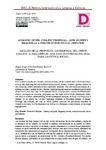Mostrar o rexistro simple do ítem
Analysis of Mr. Collins’ Proposal: Jane Austen’s Realism as a Strategy for Social Criticism
| dc.contributor.author | Jordán Enamorado, Miguel Ángel | |
| dc.date.accessioned | 2022-03-30T07:36:07Z | |
| dc.date.available | 2022-03-30T07:36:07Z | |
| dc.date.issued | 2021-12-29 | |
| dc.identifier.citation | Jordán, M. Ángel. (2021). Analysis of Mr. Collins’ proposal: Jane Austen’s realism as a strategy for social criticism. DIGILEC: Revista Internacional de Lenguas y Culturas, 8, 83-98. https://doi.org/10.17979/digilec.2021.8.0.8581 | es_ES |
| dc.identifier.issn | 2386-6691 | |
| dc.identifier.uri | http://hdl.handle.net/2183/30306 | |
| dc.description.abstract | [Abstract] Jane Austen's novels are a faithful portrait of many of the customs and rules of her time’s society. By depicting her sociocultural environment, Austen confers a greater realism to her works and adds coherence to her characters’ attitudes. She also employs realism as a strategy to make a subtle social criticism, highlighting the negative consequences of some of her time’s laws and rules. In the present article, a sociocultural context is offered about clerics, courtship and marriage proposals, and the legal device of the entailment, which will lead to a better understanding of the subsequent analysis of Pride and Prejudice’s chapter 19, in which Mr. Collins’ marriage proposal to Elizabeth Bennet is related. Through this analysis, the way in which Austen criticizes the precarious situation of women in her time will be explained, as well as its subsequent consequences on marriage engagements. | es_ES |
| dc.description.abstract | [Resumen] Las novelas de Jane Austen son un fiel retrato de muchas de las costumbres y reglas de la sociedad de su tiempo. Al reflejar el entorno sociocultural de su época, la autora confiere un mayor realismo a sus obras y aporta coherencia a la actitud de sus personajes. Austen se sirve también del realismo para realizar una sutil crítica social, poniendo de manifiesto las consecuencias negativas de algunas de las disposiciones de su época. En el presente artículo, se ofrece un análisis del capítulo 19 de Pride and Prejudice, en el que se relata la propuesta de matrimonio de Mr. Collins a Elizabeth Bennet. Por medio de este análisis, precedido de un contexto sociocultural sobre los clérigos, el cortejo, las propuestas matrimoniales y el entailment, un instrumento legal, se explicará el modo en el que Austen critica la situación de precariedad de las mujeres de su época y las consecuencias de esta situación en los compromisos matrimoniales. | es_ES |
| dc.language.iso | eng | es_ES |
| dc.publisher | Universidade da Coruña | es_ES |
| dc.relation.uri | https://doi.org/10.17979/digilec.2021.8.0.8581 | es_ES |
| dc.rights | Atribución-CompartirIgual 4.0 Internacional (CC BY-SA 4.0) | es_ES |
| dc.rights.uri | https://creativecommons.org/licenses/by-sa/4.0/deed.es | |
| dc.subject | Women’s studies | es_ES |
| dc.subject | Literary analysis | es_ES |
| dc.subject | Regency novel | es_ES |
| dc.subject | Cultural studies | es_ES |
| dc.subject | Novel and history | es_ES |
| dc.subject | Análisis literario | es_ES |
| dc.subject | Novela de regencia | es_ES |
| dc.subject | Estudios culturales | es_ES |
| dc.subject | Novela e historia | es_ES |
| dc.subject | Estudios de la mujer | es_ES |
| dc.title | Analysis of Mr. Collins’ Proposal: Jane Austen’s Realism as a Strategy for Social Criticism | es_ES |
| dc.title.alternative | Análisis de la propuesta matrimonial del señor Collins: el realismo de Jane Austen como estrategia para la crítica social | es_ES |
| dc.type | info:eu-repo/semantics/article | es_ES |
| dc.rights.access | info:eu-repo/semantics/openAccess | es_ES |
| dc.date.updated | 2022-03-25T13:29:00Z | |
| UDC.journalTitle | DIGILEC: Revista Internacional de Lenguas y Culturas | es_ES |
| UDC.volume | 8 | es_ES |
| UDC.startPage | 83 | es_ES |
| UDC.endPage | 98 | es_ES |
| dc.identifier.doi | 10.17979/digilec.2021.8.0.8581 |






